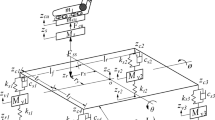Abstract
To provide initial design values of seat cushion and chassis suspension damping for wheel-drive electric vehicles (WDEVs), this paper presents an analytical estimation method and a practical damping parameters design method. Firstly, two formulae of the human body vertical acceleration in terms of the power spectrum density (PSD) and the root mean square (RMS) are deduced for WDEVs. Then, the coupling effects of the key vehicle parameters on ride comfort are revealed. Finally, with a practical example, the damping parameters of the cushion and the suspension are initially designed and analyzed. The results show that when every 10.0 kg increases for motor mass, the optimal damping values of the cushion and the suspension should be reduced by about 15.0 Ns/m and 50.0 Ns/m, respectively. However, the RMS acceleration increases 0.017 m/s2 with a decrease of 2.5 % for ride comfort.
Similar content being viewed by others
Abbreviations
- WDEVs:
-
wheel-drive electric vehicles
- RMS:
-
root mean square
- PSD:
-
power spectrum density, m2/s3
- m 3 :
-
human body mass, kg
- m 2 :
-
vehicle body mass, kg
- m 1 :
-
tire system mass, kg
- m 0 :
-
motor mass, kg
- K 3 :
-
cushion stiffness, N/m
- K 2 :
-
suspension stiffness, N/m
- K 1 :
-
tire stiffness, N/m
- C 3 :
-
cushion damping, N·s/m
- C 2 :
-
suspension damping, N·s/m
- x 3 :
-
human body bounce, m
- x 2 :
-
vehicle body bounce, m
- x 1 :
-
wheel hop, m
- q :
-
road excitation, m
- ω 3 :
-
approximate natural angular frequency of human body system, rad/s
- ω 2 :
-
approximate natural angular frequency of vehicle body system, rad/s
- ω 1 :
-
approximate natural angular frequency of tire system, rad/s
- f 3 :
-
approximate natural frequency of human body system, Hz
- f 2 :
-
approximate natural frequency of vehicle body system, Hz
- f 1 :
-
approximate natural frequency of tire system, Hz
- ξ 3 :
-
damping ratio of cushion system
- ξ 2 :
-
damping ratio of chassis suspension system
- r 2 :
-
mass ratio of human body and vehicle body
- r 1 :
-
mass ratio of vehicle body and unsprung mass
- η 1 :
-
stiffness ratio of cushion and chassis suspension
- η 2 :
-
stiffness ratio of tire and chassis suspension
- α 2 :
-
frequency ratio of human body system and vehicle body
- α 1 :
-
frequency ratio of tire system and vehicle body
- a(t):
-
human body vertical acceleration, m/s2
- σ a :
-
human body vertical RMS acceleration, m/s2
References
Beardon, A. F. (1979). Complex Analysis. 1st edn. Wiley. New York, USA.
Chen, L., Bian, M. Y., Luo, Y. G. and Li, K. Q. (2016). Tire-road friction coefficient estimation based on the resonance frequency of in-wheel motor drive system. Vehicle System Dynamics 54, 1, 1–19.
Chen, Y. and Wang, J. M. (2012). Design and evaluation on electric differentials for overactuated electric ground vehicles with four independent in-wheel motors. IEEE Trans. Vehicular Technology 61, 4, 1534–1542.
Etsuo, K. and Ayana, O. (2016). Improvement of ride comfort by unsprung negative skyhook damper control using in-wheel motors. SAE Int. J. Alternative Powertrains 5, 1, 214–221.
Hung, Y. H. and Wu, C. H. (2015). A combined optimal sizing and energy management approach for hybrid inwheel motors of EVs. Applied Energy, 139, 260–271.
Nam, K. N., Fujimoto, H. and Hori, Y. (2012). Lateral stability control of in-wheel-motor-driven electric vehicles based on sideslip angle estimation using lateral tire force sensors. IEEE Trans. Vehicular Technology 61, 5, 1972–1985.
Li, X. H. and Qian, H. (2012). The present status and future trends of in-wheel motors for electric vehicles. Materials Science and Information Technology, 433-440, 6943–6950.
Mastinu, G. R. M., Gobbi, M. and Pace, G. D. (2001). Analytical formulae for the design of a railway vehicle suspension system. Proc. Institution of Mechanical Engineers, Part C: J. Mechanical Engineering Science 215, 6, 683–698.
Nakhaie, J. C., Alkhatib, R. and Golnaraghi, M. F. (2006). Root mean square optimization criterion for vibration behavior of linear quarter car using analytical methods. Vehicle System Dynamics 44, 6, 477–512.
Selim, S., Can, A. A. and Çaglar, B. S. (2016). Parametric analysis and compensation of ride comfort for electric drivetrains utilizing in-wheel electric motors. Int. J. Simulation: Systems, Science and Technology 17, 33, 7.1–7.8.
Sun, W., Li, Y. N., Huang, J. Y. and Zhang, N. (2015). Vibration effect and control of in-wheel switched reluctance motor for electric vehicle. J. Sound and Vibration, 338, 105–120.
Tang, L., Shangguan, W. B. and Dai, L. (2012). A calculation method of joint forces for a suspension considering nonlinear elasticity of bushings. Proc. Institution of Mechanical Engineers, Part K: J. Multibody Dynamics 226, 4, 281–297.
Tong, W. and Hou, Z. C. (2014). Analyses on the vertical characteristics and motor vibration of an electric vehicle with motor-in-wheel drive. Automotive Engineering 36, 4, 398–403.
Yu, F. and Lin, Y. (2005). Vehicle System Dynamics. 1st edn. China Machine Press. Beijing, China.
Yu, Z. S. (2009). Automobile Theory. 5th edn. China Machine Press. Beijing, China.
Zhao, L. L., Zhou, C. C. and Yu, Y. W. (2016). Hybrid modeling of seat-cab coupled system for truck. Int. J. Automotive Technology 17, 5, 769–776.
Author information
Authors and Affiliations
Corresponding author
Rights and permissions
About this article
Cite this article
Yang, F., Zhao, L., Yu, Y. et al. Analytical description of ride comfort and optimal damping of cushion-suspension for wheel-drive electric vehicles. Int.J Automot. Technol. 18, 1121–1129 (2017). https://doi.org/10.1007/s12239-017-0109-2
Received:
Revised:
Accepted:
Published:
Issue Date:
DOI: https://doi.org/10.1007/s12239-017-0109-2




